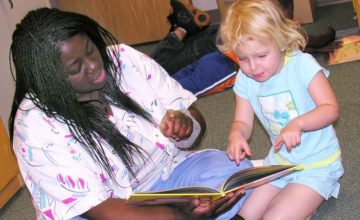Talking with babies doesn’t just build vocabularies; it also nurtures the development of cognitive and social-emotional skills, now and into your baby’s future.
Learning how to talk to babies is one of the most powerful ways to support their early development and help them thrive.These early interactions support key communication milestones in early childhood, setting the stage for lifelong learning and connection.
Here are some tips on how to talk to babies and build strong language skills from birth:
1. Talk to babies in their language—parentese!
Parentese is the high-pitched tone of voice, simple sentences, and stretched out vowels (“hiiii, bayyybeeee!”) that adults automatically tend to use with young babies. Research has found that babies prefer this type of speech over typical adult speech, perhaps because the exaggerated sounds help them learn the sounds of their home language. It’s important to know that parentese and “baby talk” are very different. Parentese uses actual language and exaggerates it (“look at the dog” might become “Looook! Dogggggy!”). Baby talk is a combination of nonsense syllables (“goo goo ga ga”) that doesn’t engage babies in the same way, nor offer the same language benefits. The good news is that you don’t have to “learn” parentese since it seems we are hard-wired to talk this way to babies.
2. Respond and put words to your baby’s gestures, looks and sounds.
When your baby raises his arms up toward you, say “you want to be picked up!” When he coos, coo back. When he gazes at you, make eye contact and talk with him. These immediate and sensitive responses tell your baby that his communications are important and effective, which motivates him to keep communicating. These interactions play a critical role in supporting communication milestones in early childhood, such as understanding gestures, vocalizing in response, and early turn-taking.
3. Make it a conversation, not a one-way street.
Be sure to pause when talking with your little one to give her a chance to respond. When thinking about how to talk to babies, ask questions (yes, even with a baby), like “Which book should we read” as you hold up 2 books, and watch how she responds: “You are looking at the story about the bear—let’s read that one!” Babies begin to engage in back-and-forth interactions as early as 3 months old. This means they begin to wait for pauses and respond with babbles, coos, smiles, or even body movements like kicking their legs or reaching out their arms. Pausing during interactions and looking expectantly at your baby lets her know when it’s her turn to “speak” and teaches her about the back-and-forth of communication.
4. Narrate what you do as you go through your daily routines.
Research shows that the number of words children hear and the quality of language (rich, descriptive talk) in the first three years are associated with larger vocabularies at age 4. Research also shows that one of the best ways for children to learn language is by talking about what you’re doing as you go through your daily routines. This kind of language helps children connect words with objects and actions. “I’m putting your socks in your tall dresser. You love your fluffy, soft socks!” Or, “Here we go into the bathtub. Your arms, legs, and tummy are getting all wet with water! Rubber Ducky is having a bath too.” While driving, talk about what you see outside the window. This kind of real-time narration builds a strong foundation for achieving communication milestones in early childhood.
5. Read, read, and read some more.
A large body of research shows that reading with your baby helps develop strong language skills far into the future. Cuddle together for quiet times with a book—whether it’s bedtime or you’re waiting for the bus. Encourage your older baby to turn the pages and to point to what he sees. Ask questions about the pictures or see if your toddler wants to tell you the story herself. Studies show that lifelong readers are those who, as children, simply found reading a pleasurable experience. Reading aloud is another essential piece in the puzzle of how to talk to babies—it introduces rhythm, emotion, vocabulary, and the joy of shared storytelling.



